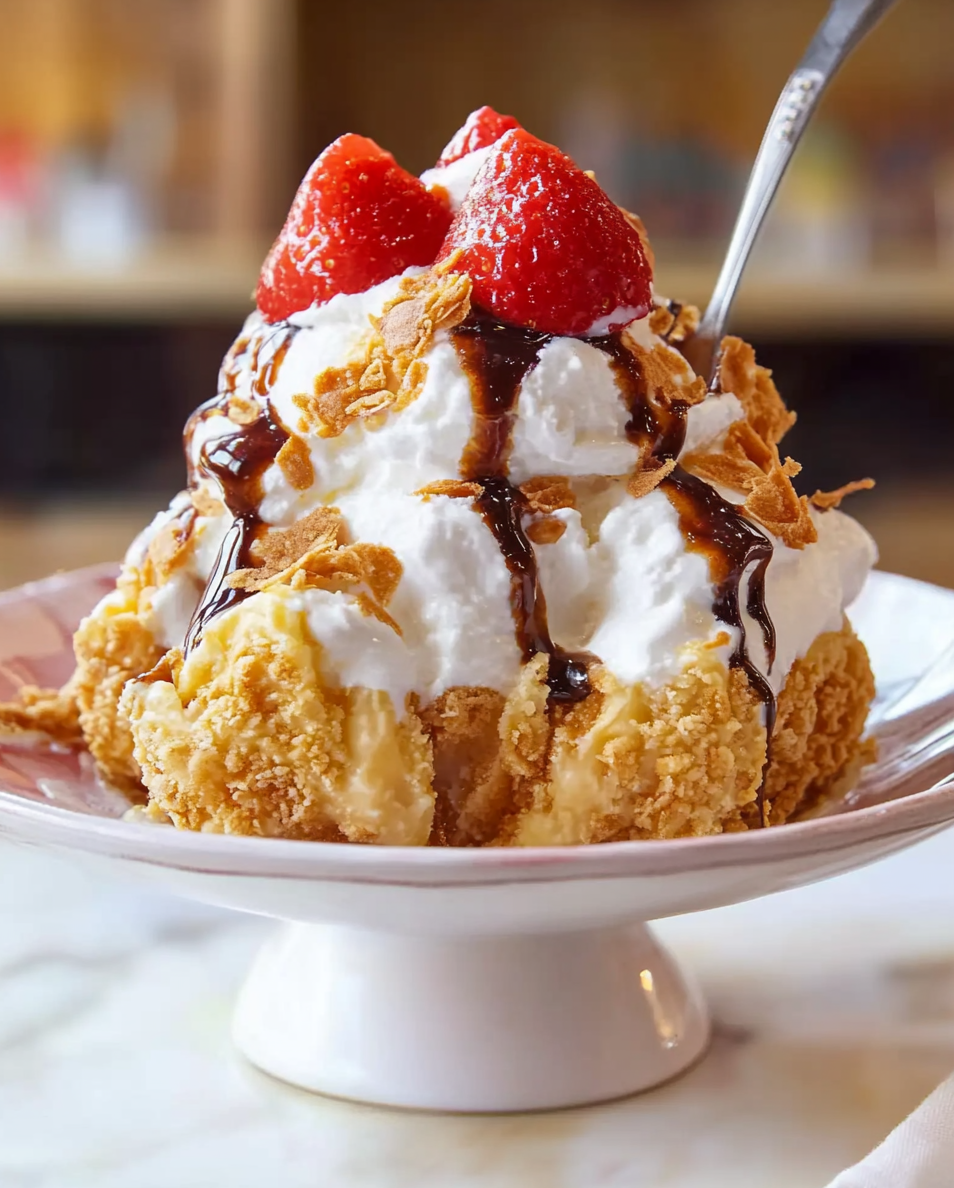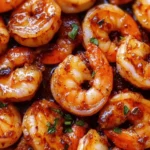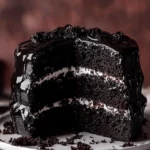Fried Ice Cream is a dessert that captures attention with its unique blend of textures and flavors. This dish features a crispy, golden coating that encases a scoop of cold, creamy vanilla ice cream. The concept of frying ice cream might seem unusual, but it’s a simple process that creates a dramatic result, combining the warmth of the fried outer layer with the refreshing coolness inside. Here’s a deeper dive into what makes this dessert so special:Ingredients Breakdown
- Ice Cream: Vanilla is the classic choice for its rich, creamy texture and neutral flavor, but you can experiment with other flavors like chocolate, coffee, or even fruity options like strawberry.
- Cornflakes and Cinnamon: The crushed cornflakes give the ice cream its signature crunch, while cinnamon adds a warm, spicy note that complements the sweetness of the ice cream.
- Egg Whites: These help the cornflake mixture adhere to the ice cream balls, creating a sturdy coating that can withstand the frying process.
- Oil for Frying: A neutral oil with a high smoke point, like vegetable or canola oil, is ideal for frying to ensure a crispy outer layer without imparting any unwanted flavors.
- Garnishes: Whipped cream, honey, and cherries add an extra layer of sweetness and visual appeal, turning this dessert into a show-stopper.
- Preparing the Ice Cream Balls: Scooping the ice cream and freezing it into firm balls is crucial. This step ensures the ice cream holds its shape during frying and remains frozen inside.
- Coating the Ice Cream: The double coating process (first with egg whites, then with the cornflake mixture) is key to creating a thick, crispy layer that protects the ice cream from melting too quickly when fried.
- Freezing Again: After coating, the ice cream balls need to be refrozen to set the coating and prevent the ice cream from leaking out during frying.
- Frying: The frying process is quick (just 10-15 seconds) and should be done at a high temperature to crisp the coating without melting the ice cream. The result is a perfectly fried, golden-brown shell encasing the cold ice cream.
- Serving: Serve immediately with your favorite garnishes. The contrast between the warm, crunchy exterior and the cold, creamy interior creates a sensational eating experience.
Tips for Success
- Work Quickly: Ice cream melts fast, so work quickly when coating and frying.
- Freeze Thoroughly: Ensure the coated ice cream balls are frozen solid before frying to maintain their shape and texture.
- Experiment with Flavors: Customize this recipe by using different ice cream flavors or adding spices to the coating mixture for a unique twist.
Origins and Variations
Fried Ice Cream has an intriguing history, with origins that are often debated. Some claim it originated in Asian cuisine, particularly in Japanese tempura-style cooking, while others suggest it was first introduced in American-Chinese restaurants. Another theory traces its roots to Mexican cuisine, where it became popular in Tex-Mex restaurants. Regardless of its true origins, Fried Ice Cream has become a beloved dessert across various cultures, each adding its own twist to the classic recipe.
- Asian Style: In Japanese and Chinese variations, the ice cream is often wrapped in a thin layer of cake or bread before being fried. This provides an additional layer of insulation, helping keep the ice cream solid during frying.
- Mexican Style: In Mexican-inspired versions, the coating is typically made with crushed cornflakes or cookie crumbs mixed with cinnamon. It is often topped with honey, chocolate sauce, or caramel for an extra layer of sweetness.
- American Style: This version often incorporates various cereals like cornflakes or granola for the coating, and it is typically served with a dollop of whipped cream and a cherry on top.
Dietary Adaptations
Fried Ice Cream can be adapted to suit various dietary needs without losing its delicious appeal. Here are some ways to make it more inclusive:
- Gluten-Free: Use gluten-free cornflakes or gluten-free cereal options for the coating to make this dessert suitable for those with gluten intolerance.
- Vegan: Substitute dairy-free ice cream and use plant-based egg substitutes like aquafaba (chickpea brine) to coat the ice cream. You can also choose plant-based whipped cream for garnishing.
- Low-Sugar: Opt for a sugar-free ice cream variety and use unsweetened cereal for the coating. You can sweeten the coating with natural sweeteners like stevia or monk fruit if desired.
Serving Suggestions
Fried Ice Cream is a versatile dessert that can be served in various ways to suit the occasion:
- For a Festive Touch: Serve it in a martini glass with a drizzle of caramel sauce and a sprinkle of chopped nuts for an elegant presentation.
- Family Gatherings: Place the fried ice cream balls on a platter and let everyone top their own with whipped cream, chocolate sauce, or fresh fruit.
- Casual Enjoyment: Enjoy it simply with a dusting of powdered sugar and a drizzle of honey for a quick and satisfying treat.
Storage and Reheating
While Fried Ice Cream is best enjoyed fresh, you can prepare the coated ice cream balls in advance:
- Freezing: Once coated, store the ice cream balls in an airtight container in the freezer for up to 1 week. Make sure they are thoroughly frozen before frying.
- Frying: When ready to serve, fry the ice cream balls directly from the freezer without thawing. This ensures the ice cream remains cold and firm during the frying process.
Nutritional Information
Fried Ice Cream is a decadent treat, so it’s meant to be enjoyed in moderation. Here’s a general overview of its nutritional profile per serving:
- Calories: Approximately 400 kcal
- Fat: Around 20g (depending on the type of ice cream and frying oil used)
- Carbohydrates: Roughly 50g (varies with the coating ingredients)
- Protein: About 5g
- Sugars: Approximately 30g (from ice cream and garnishes)
This dessert is rich and indulgent, making it perfect for special occasions when you want to treat yourself or impress your guests with something unique.
Conclusion
Fried Ice Cream is more than just a dessert; it’s a delightful experience that brings together contrasting elements in a harmonious way. Its crunchy, warm exterior paired with the soft, cold ice cream inside makes it a favorite for many. Whether you’re hosting a dinner party or simply indulging in a special treat, this dessert promises to impress and satisfy your sweet cravings.






